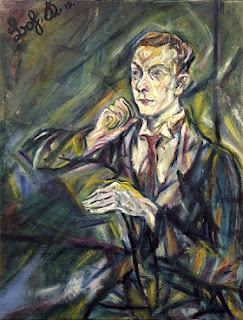
Bohuslav Kokoschka...
Portrait of Otto Kallir at the Age of Twenty-Five (1919, Oil on canvas, Signed and dated, upper left). From the exhibition
Who Paid the Piper? The Art of Patronage in Fin-de-Siècle Vienna, March 8 - May 26, 2007 at Galerie St. Etienne, New York. "...Fin-de-siècle Vienna is widely hailed for the groundbreaking achievements of artists such as Gustav Klimt, Egon Schiele and Oskar Kokoschka. Less well known, however, are the patrons who supported these artists and thereby made their achievements possible. Vienna in 1900 was a city poised at a crossroads between two collecting paradigms: aristocratic patronage, on the one hand, and the capitalistic art market, on the other. Historically, the Catholic Church and the Imperial Court had been the principal patrons of the arts in Austria, but around 1800, these institutions began to relinquish their hegemony to the emerging bourgeoisie. Over the course of the ensuing century, industrialization multiplied both the number and the fortunes of bourgeois collectors. Increased mobility turned Vienna into a modern metropolis. People representing a broad mix of cultural, ethnic and linguistic backgrounds streamed in from all over the Austro-Hungarian Empire, creating a dynamic, melting-pot society. By 1910, Vienna’s population stood at two million. (It is today 1.6 million.) A late-nineteenth-century building boom gave the city the most advanced infrastructure in all of Europe."
 Bohuslav Kokoschka... Portrait of Otto Kallir at the Age of Twenty-Five (1919, Oil on canvas, Signed and dated, upper left). From the exhibition Who Paid the Piper? The Art of Patronage in Fin-de-Siècle Vienna, March 8 - May 26, 2007 at Galerie St. Etienne, New York. "...Fin-de-siècle Vienna is widely hailed for the groundbreaking achievements of artists such as Gustav Klimt, Egon Schiele and Oskar Kokoschka. Less well known, however, are the patrons who supported these artists and thereby made their achievements possible. Vienna in 1900 was a city poised at a crossroads between two collecting paradigms: aristocratic patronage, on the one hand, and the capitalistic art market, on the other. Historically, the Catholic Church and the Imperial Court had been the principal patrons of the arts in Austria, but around 1800, these institutions began to relinquish their hegemony to the emerging bourgeoisie. Over the course of the ensuing century, industrialization multiplied both the number and the fortunes of bourgeois collectors. Increased mobility turned Vienna into a modern metropolis. People representing a broad mix of cultural, ethnic and linguistic backgrounds streamed in from all over the Austro-Hungarian Empire, creating a dynamic, melting-pot society. By 1910, Vienna’s population stood at two million. (It is today 1.6 million.) A late-nineteenth-century building boom gave the city the most advanced infrastructure in all of Europe."
Bohuslav Kokoschka... Portrait of Otto Kallir at the Age of Twenty-Five (1919, Oil on canvas, Signed and dated, upper left). From the exhibition Who Paid the Piper? The Art of Patronage in Fin-de-Siècle Vienna, March 8 - May 26, 2007 at Galerie St. Etienne, New York. "...Fin-de-siècle Vienna is widely hailed for the groundbreaking achievements of artists such as Gustav Klimt, Egon Schiele and Oskar Kokoschka. Less well known, however, are the patrons who supported these artists and thereby made their achievements possible. Vienna in 1900 was a city poised at a crossroads between two collecting paradigms: aristocratic patronage, on the one hand, and the capitalistic art market, on the other. Historically, the Catholic Church and the Imperial Court had been the principal patrons of the arts in Austria, but around 1800, these institutions began to relinquish their hegemony to the emerging bourgeoisie. Over the course of the ensuing century, industrialization multiplied both the number and the fortunes of bourgeois collectors. Increased mobility turned Vienna into a modern metropolis. People representing a broad mix of cultural, ethnic and linguistic backgrounds streamed in from all over the Austro-Hungarian Empire, creating a dynamic, melting-pot society. By 1910, Vienna’s population stood at two million. (It is today 1.6 million.) A late-nineteenth-century building boom gave the city the most advanced infrastructure in all of Europe."



0 Comments:
Post a Comment
<< Home